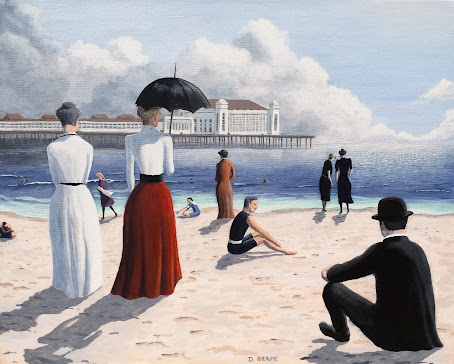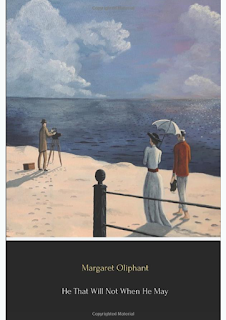A "Sea Change" in our Morality
It wasn't until about the mid nineteenth century that the idea of going to the beach for a holiday began to take hold with the general public. Prior to that it had primarily been a thing for the nobility, who on the advice of their physicians, sought the restorative effects of bathing in the sea. It was the industrial revolution that started to change the equation. Mechanization meant that humans were less and less involved in the brute efforts of tending the land and more likely to be employed in the cities. As such, fleeing the tight confines of urban life for the seaside became more and more desirable, and the increasing sophistication of the railway system meant more and more people could make that escape. Seaside resort towns, especially in Britain, flourished during the nineteenth century.
What fascinates me about beach-going images from the Victorian and Edwardian era is the uneasy relationship between the practical need to de-clothe at the beach and the prevailing morality of the day. Beaches have been the front line, not just for actual armed combat, but also in the fashion-related battles over what we deem is 'decent'. When boundaries were pushed, whether over hem lengths or even male toplessness, the setting was more often than not the beach.
Even the word "bikini" which takes its name from an atoll in the South Pacific, does so not because it's some homage to warm tropical climes. Bikini Atoll was obliterated in an atomic bomb test...and the new, scandalous suits that debuted in 1946 were said to have had a similar devastating effect on public morality.
And so "what to wear at the beach" wasn't always as straightforward as it is today. The painting at the start of this blog, "Atlantic City Beach" is a composite of two images...the pier at Atlantic City, and an archival picture I found from 1905 showing people at Palm Beach. The chap in the bowler hat was indeed wearing his full black suit as he rested on the sand.
But as incongruous as this beachwear may seem, Victorian morality arguably manifested itself most oddly with the presence of the bathing machine.
The concept was relatively simple. It was a changing booth with doors on both sides mounted on a wagon chassis. The occupant could enter the booth in their street clothes and have complete privacy while changing into swimwear. The booth was then towed out into the surf by horse and the occupant could enter the water without ever having to make an appearance on the beach. The device had existed since the 18th century, but by the Victorian era their presence was more or less universal on beaches worldwide. They continued to be a common beach sight until their gradual fading away in the early decades of the twentieth century.
By now I've done several paintings that include bathing machines. Part of it is that they fit the era I like to paint. But I'm also drawn to the bright colours and patterns they tended to come in. As an artist, it's a good opportunity to inject some punchy yellows and reds into the tans and aquas of a typical beach scene. And they're also a reminder...of how much times change and how many of those societal battles took place in the idyllic places where we sought rest and refuge.












Comments
Post a Comment